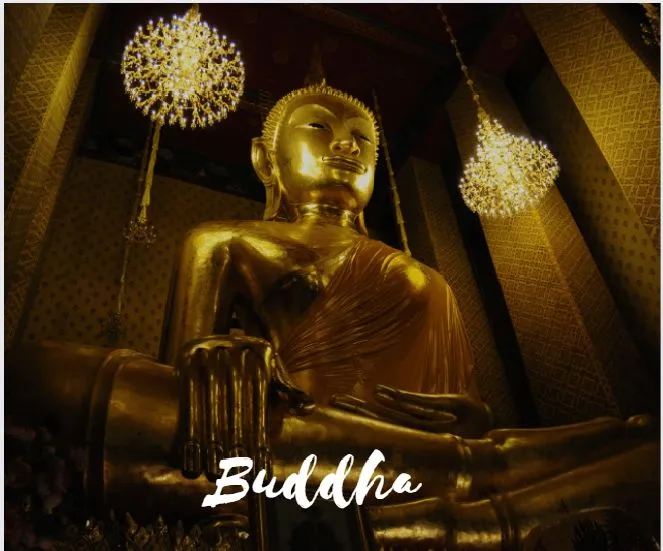Born in the ancient Indian kingdom of Magadha, Śāriputra was one of the chief male disciples of the Buddha and existed alongside the great religious leader as the leading functionary of his band of disciples.
Today, he is considered one of the most important disciples of the Buddha and had a crucial role in leadership in the Buddha’s band of disciples.
Often called the man with the “golden complexion,” Śāriputra was an enlightened monk. He was ordained by none other than the Buddha himself. In Theravada Buddhism, the oldest school of Buddhism, he enjoys a status close to the second Buddha.
Below, we’re going to learn more about a man who wasn’t just a close follower of the Buddha.
According to Gautama Buddha himself,
“Śāriputra had achieved enlightenment and was a source of wisdom in his own right.”
Table of Contents
ToggleBirth in Magadha to Śārī: The Early Life of Śāriputra
According to Buddhist texts, Śāriputra was born “Upatiṣya” to a family in the ancient Indian kingdom of Magadha, in a village near Rajgir, or the City of Kings. Different from birth, young Upatiṣya was said to have a golden complexion, along with six siblings.
The name Śāriputra derives from his mother, who was named Śāri because she had eyes like a śārika bird. Translated, the name Śāriputra means “Son of Śāri.”
Buddhist texts also hold that Śāriputra was born on the same day as Kolita, the man who would come to be known as Maudgalyāyana, the second chief male disciple of Gautama Buddha.
Their history, however, did not start with the Buddha alone: the families of both youths had been friends for many generations.
Their education made them masters of the Vedas, and both became leaders of their groups of Brahmin youths. However, realizing one day that life is fleeting and impermanent, both left their village, seeking spiritual enlightenment.

Becoming Spiritual Wanderers: The Path That Led to the Buddha
For a while, Śāriputra and Maudgalyāyana were spiritual wanderers, traveling from city to city and visiting different spiritual teachers. However, they found none of them to their liking, realizing that none were following the right path. Both Śāriputra and Maudgalyāyana eventually became students of Sañjaya Vairatiputra, an ascetic teacher.
At this point, documents from different Buddhist texts differ on how they came to leave Sañjaya. Some hold that they became dissatisfied with his doctrine and left, while others still proclaim that the teacher became ill and died, leading to the two youths leaving.
After leaving Sañjaya, Upatiṣya met Aśvajit, a monk. He was one of the Buddha’s first five arhat disciples (in Buddhist doctrine, an arhat is a person who has gained an insight into the true nature of existence).
The youth noticed that the monk had a serene expression and decided to approach and ask for a teaching from him.
At this point, Aśvajit said he had only been newly ordained, so he was not as knowledgeable as some. Still, the stanza he recited became a big part of mainstream Buddhism and went as follows:
“Of all those things that from a cause arise,
Tathagata the cause thereof has told;
And how they cease to be, that too he tells,
This is the doctrine of the Great Recluse.”
Meeting the Buddha and Being Proclaimed First Disciple: Śāriputra’s Life Under the Buddha
Upatiṣya attained sotapanna, considered the first stage of enlightenment, after hearing the teaching. Kolita, who listened to the stanza after Upatiṣya sought him out to tell him about it, also attained sotapanna.
At this point, the two friends were ordained as monks by the Buddha, along with a large chunk of students and youths who had followed them from Sañjaya’s camp. Everybody in the group attained arhat that day except for Upatiṣya and Kolita.
According to Buddhist teachings, both of them required longer periods of meditation to fulfill the roles of chief male disciples of the Buddha.
This is also the period where they picked up their well-known names:-
✪ Upatiṣya became Śāriputra, the first chief male disciple of Gautama Buddha,
✪ And Kolita became Maudgalyāyana, the second chief male disciple.
Maudgalyāyana attained arhat seven days after being ordained as a monk, and Śāriputra took two whole weeks. He had spent these two weeks in intense meditation. He attained arhat while fanning the Buddha as he was reciting the Vedanāpariggaha Sutta to an ascetic. Following Buddhist tradition, both of them were appointed as the two chief disciples of Gautama Buddha.
Śāriputra’s Role as First Disciple And His Responsibilities
Considered to be the “excellent pair,” Maudgalyāyana and Śāriputra were supposed to be the wisest of the Buddha’s disciples. Texts say that none of the other monks or students could answer questions that Maudgalyāyana could and that he could not answer questions Śāriputra found the answers to.
➤ Śāriputra’s role as first chief disciple was mainly categorizing the Buddha’s teachings: he would ask the great religious leader questions and often entreat him to elaborate on topics.
➤ He would also clarify his teachings for fellow students, as the Buddha considered him the wisest of all his monks.
➤ Śāriputra also assumed a leadership role in the Buddha’s community of monks. He would attend to sick or dying monks, and he was also the first disciple asked by the Buddha to ordain other monks.

The Death of Śāriputra
All Buddhist texts agree that Śāriputra died shortly before the Buddha himself, with most also concluding that he died in his hometown near Rajgir.
According to both Pāli commentaries (the longest preserved records of Buddhism) and the Mūlasarvāstivāda texts, Śāriputra and Maudgalyāyana achieved parinirvana, the state of nirvana in death, before their deaths.
A funeral for Śāriputra was held in Rajgir, with his remains cremated. This venerable monk’s relics are commonly held to be enshrined at Jetavana, one of the largest Buddhist monasteries in India.
What We Can Learn From Śāriputra: A Conclusion
The life of this great monk at the side of the Buddha isn’t just one you’ll find online. Śāriputra is mentioned in most Buddhist books, often in heartwarming stories. In one, he finds himself switching bodies with a goddess trying to make him understand that gender doesn’t matter in nirvana.
While the circumstances seem fantastical, it’s undeniable that his teachings and stories can be applied to our own lives to get a better understanding of the world. If that seems too lofty a goal, they also make us a better person overall and teach us that everybody is equal on Earth.
FAQs-
• Who was Buddha's closest disciple?
Anand and Sariputra were the Buddha’s beloved and closest disciples.
• Digha Nikaya
The Digha Nikaya is a Buddhist scripture, the first of the five nikayas, or collections, in the Sutta Pitaka, one of the “Three Baskets” that form the Pali Tipitaka of Buddhism.
• Tibetan monks(Tibetan Buddhism)
Tibetan Buddhism is the form of Buddhism practiced in Tibet and Bhutan, where it is the dominant religion.
• Buddha, all names
Buddha has thousands of names. Some of them are Bhagwan buddha, Reclining buddha, Amitabha buddha, Maitreya buddha, Yama Buddhism, laughing buddha, Siddhartha Gautama, Gautama buddha
lord buddha, mahatma buddha, tian tan buddha, and many more.
• Buddha's teachings
The Five Precepts
Refrain from taking life.
Refrain from taking what is not given.
Refrain from the misuse of the senses.
Refrain from wrong speech.
Refrain from intoxicants that cloud the mind.
• Māyādevī (Who was Buddha's mother?)
Queen Māyādevi of Sakya kingdom was the birth mother of Gautama Buddha, the sage on whose teachings Buddhism was founded. She was the sister of Mahāpajāpatī Gotamī, the first Buddhist female ordained by the Buddha.
• Who is Buddha's wife?
Prince Gautam’s wife’s name was Yashodhara.
• Tantric Buddhism
Esoteric practices and obscure sects are found in all forms of Buddhism.
• Buddha mantra
Oṃ maṇi padme hūṃ
• The Buddha and his dhamma
The Buddha and His Dhamma is a book on Buddha’s life and philosophy. Dr. B. R. Ambedkar wrote it.
• Buddha wall painting
There are many caves in India and worldwide where we can find many old paintings of a buddha. Ajanta and Allora caves are famous for buddha paintings.
• Jainism and Buddhism
Jains believe in the presence of an eternal Jiva soul, whereas Buddhism denies the concept of soul (atman), proposing the idea of no-self (anatta) instead.
• Enlightenment Buddhism
Buddhists consider human life a cycle of suffering and rebirth but that if one attains a state of enlightenment (nirvana), it is feasible to escape this cycle forever.
• Gautam buddha birth place
Lumbini, Nepal, is the birthplace of Buddha.
• Gautam buddha images, lord buddha images
You can search on google for buddha images.
• The heart of the buddha's teaching
The heart of the buddha’s teaching is a book based on lord buddha written by Thich Nhat Hanh.
• Chinese buddha
Chinese buddha is called Budai, also known as laughing buddha.
• Buddhist countries -What are the top 10 Buddhist countries?
Buddhism is the predominant religion in Bhutan, Myanmar, Cambodia, Mainland China, Hong Kong, Japan, Tibet, Laos, Macau, Mongolia, Singapore, Sri Lanka, Taiwan, Thailand, Kalmykia and Vietnam.
• Buddhist philosophy- What is the main philosophy of Buddhism?
The ultimate goal instructed by the Buddha, Nirvana, literally means ‘extinguishing’ and signified “the complete extinguishing of greed, hatred, and delusion, the forces which power samsara.
• Buddhist monastery
Buddhist monasteries are generally called vihara. There are hundreds of monasteries in the world.
• Laughing buddha statue -Which Laughing Buddha statue is good for home?
As we all know, Laughing Buddha brings good luck, contentment and abundance to one’s life.
• Types of Buddhism
Theravada, Mahayana and Vajrayana
• Gautam buddha in hindi
Gautam Buddha in hindi, about Gautam buddha, Buddhism in Tamil, Buddha in a Traffic Jam, Budhha Smriti Park, Buddhism is the major religion we can learn on google.
• When is Buddha Purnima 2023?
5 May, Friday Buddha’s Birthday 2023 in India
